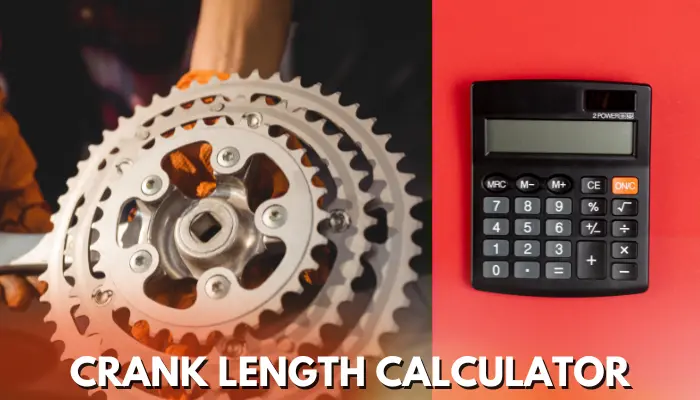Finding The Optimum Crank Length Calculations For Your Bike

While there are many various sizes of bike riders’ legs, bikes are typically offered with only one crank length. Consequently, it probably makes sense to employ cranks that are equivalent to the rider’s leg length. A crank length calculator is a tool used to determine the optimal length of crank arms for a bike. The length of the crank arms can have a significant impact on a rider’s comfort, efficiency, and power output.
The calculator typically takes into account several factors, such as the rider’s height, inseam length, and riding style, to recommend the ideal crank length. The goal is to find a length that maximizes the rider’s power output while minimizing the risk of injury or discomfort.
Crank Length Calculator
Crank Length Calculator
Recommended Crank Length: 0 mm
Optimum Crank Length Calculator:
Crank length calculators are often used by cyclists who are looking to optimize their performance or comfort on their bikes and can be found online or as part of fitting bike services. It’s important to note that while a crank length calculator can be a helpful tool, there is no one-size-fits-all solution, and the best crank length for a particular rider may still require some experimentation and adjustment.
Note: It is important to remember that the crank length calculator basically gives you an approximation of your optimum crank length in proportion to your leg length. Verify with a qualified bike fitter if you are still doubtful.
Importance Of Crank Length Calculator:
A crank length calculator is an important tool for bikers as it helps them determine the optimal length of the crank arms on their bike’s crankset. The length of the crank arms can have a significant impact on the rider’s comfort, power output, and overall performance.
The optimal crank length for a biker depends on several factors, such as the rider’s height, inseam length, riding style, and the type of biking they will do. A crank length calculator takes these factors into account and recommends the ideal crank length for the rider.
Having the correct crank length can improve the rider’s riding efficiency, reduce the risk of injury, and make riding more comfortable. If the crank arms are too long or too short, it can cause discomfort or pain in the knees, hips, and lower back. It can also affect the rider’s power output and make it harder to maintain a consistent cadence. Therefore, using a crank length calculator to determine the optimal crank length for your bike can help you achieve the best possible performance and comfort while biking.
How To Use This Calculator:
A crank length calculator can be useful for determining the appropriate length of cranks for your bike. Here are the general steps for using a crank length calculator:
- Gather your measurements:
You will need to know your inseam length and your saddle height. Measure your inseam length by standing with your back against a wall and placing a book between your legs. Measure the distance from the floor to the top of the book. Measure your saddle height by measuring the distance from the center of your bottom bracket to the top of your saddle.
- Input your measurements:
Enter your inseam length and saddle height into the crank length calculator. Some calculators may also ask for your shoe size.
- Review the results:
The calculator will provide you with a recommended crank length based on your measurements. It may also provide a range of acceptable crank lengths.
- Consider your riding style:
The recommended crank length may not be suitable for all riding styles. Longer cranks may be beneficial for riders who prefer a more powerful riding stroke, such as sprinters and climbers. Shorter cranks may be more suitable for riders who prefer a higher cadence, such as time trialists and triathletes.
- Consult with a professional:
If you are unsure about the recommended crank length, consider consulting with a bike fitter or a professional at your local bike shop. They can help you determine the appropriate crank length for your riding style and body type.
How To Choose The Perfect Crank Length:
Although they are available in common sizes on the majority of bikes, depending on the length of your upper body and lower body, you may have trouble riding the crank that is most efficient for you. The crank is possibly the most significant point of touch between your bike and you.
Your physical readiness, vitality, and passion are aimed there with the goal of progressively higher speed. Finding the ideal crank length for yourself is an extremely individualized process, which is where art overcomes science in this scenario.
Choosing the perfect crank length for a bike depends on several factors, including your riding style, body type, and terrain. Here are a few things to consider when selecting a crank length:
Riding style:
You may prefer a longer crank length to generate more power and leverage if you’re a road biker. If you’re a mountain biker, you may prefer a shorter crank length to clear obstacles and have better control of technical terrain.
Body type:
Your leg length and hip flexibility should also be taken into account. Generally, shorter riders may benefit from shorter crank lengths, while taller riders may prefer longer crank lengths. Also, riders with limited hip flexibility may prefer shorter crank lengths to reduce the amount of knee bend during the riding stroke.
Terrain:
The type of riding you do will also impact your crank length selection. For example, a longer crank length may be suitable if you ride on flat terrain. If you ride in steep terrain, a shorter crank length may be a better choice.
Personal preference:
Ultimately, the perfect crank length comes down to personal preference. It’s essential to test out different crank lengths to see which one feels the most comfortable and efficient for your riding style and body type.
In summary, choosing the perfect crank length requires a balance between several factors, including your riding style, body type, terrain, and personal preference. It’s important to experiment with different lengths to find the one that works best for you.
Benefits Of Using Our Calculator:
A crank length calculator can be a valuable tool for determining the optimal length of cranks for your bike. Here are some benefits of using a crank length calculator:
- Improved Comfort:
A properly sized crank length can help reduce joint pain and improve overall comfort while riding.
- Increased Efficiency:
The right crank length can improve your pedaling efficiency by allowing you to maintain a smooth and consistent cadence.
- Enhanced Power Output:
By optimizing your crank length, you may be able to generate more power with each pedal stroke, which can improve your speed and performance.
- Better Bike Fit:
The right crank length can help you achieve a better bike fit, which can improve your overall riding experience and reduce the risk of injury.
- Personalization:
A crank length calculator takes into account your individual body measurements and riding style, which can result in a more personalized and optimal bike setup.
Potential Risks Of Using Such Calculators:
Like any tool or device, there are potential risks associated with using crank-length calculators.
- One potential risk is that the results provided by the calculator may not be accurate or may not take into account individual factors such as injury history, flexibility, or riding technique. It is important to remember that these calculators provide general guidelines and should not be relied on as the sole determinant of crank length.
- Another risk is that some cyclists may become overly focused on the results of the calculator and feel pressure to conform to a specific crank length, even if it does not feel comfortable or natural for their individual riding style. It is important for cyclists to experiment with different crank lengths and make adjustments based on their own comfort and performance.
- Finally, it is important to note that crank length is just one factor among many that can affect a cyclist’s performance and comfort on the bike. Other factors such as saddle height, handlebar position, and shoe-cleat alignment should also be considered when making adjustments to bike fit.
Factors Affecting A Rider Crank Length:
The main factors affecting crank length are rider body proportions, riding style, and personal preference.
- Rider body proportions play a significant role in determining the appropriate crank length. A rider with longer legs will typically require a longer crank length, while a rider with shorter legs will require a shorter crank length. This is because the length of the crank arm affects the range of motion of the rider’s leg, and a crank that is too long or too short can result in inefficient pedaling mechanics and discomfort.
- Riding style can also impact the appropriate crank length. For example, a road cyclist who prioritizes aerodynamics may prefer a shorter crank length to reduce their frontal area. In comparison, mountain biker who values power and leverage may prefer a longer crank length to improve their ability to climb steep terrain.
- Finally, personal preference also plays a role in the selection of crank length. Some riders may simply feel more comfortable and efficient with a particular crank length, regardless of their body proportions or riding style.
FAQs
Why do conventional cranks have that certain length?
For bikes, the most commonly used crank lengths are 170mm, 172.5mm, and 175mm. The size of the frame will likely determine what size bike you have. Small bikes generally have 170mm cranks, medium bikes have 172.5mm, and bigger bikes have 175mm.
Why do people use 165mm cranks?
The experts’ brief explanation of why shorter cranks, or 165mm for a standard male adult rider, are a positive thing is as follows: Sprinters and time trialists may now ride in a lower, more streamlined posture thanks to them. They make riding easier and more enjoyable.
Which crank arm is superior, 170mm or 175mm?
While using 170mm cranks instead of 175mm cranks, riders were able to attain their peak power over one second faster. This means that shorter cranks offer riders better acceleration, which might be essential when overtaking other riders or having to clear an obstacle.
What are the advantages of shorter cranks?
These include things such as increasing one’s capacity for spinning at a greater cadence, improving bike clearance during turns, or reducing lower back, joints, or muscle pain. When riding a bike in an aerodynamic position, shorter cranks might help alleviate fitting problems such as knees smashing into your chest area or the bike handlebars.
What role does crankset size play?
The use of crank length as a measure may assist with fit-related problems that affect convenience, power, and wind resistance. It can be improved by switching to a shorter crank. Knee (extending and flexing) range of motion, hip range of motion, and low back range of motion are all decreased by a shorter crank length.
How long a crank should I use for hills?
The ideal crank length for an athlete seems to be between 162.5mm and 167.5mm, depending on their height and leg length (the tallest and longest one may need 170mm cranks).
How much power does crank length affect?
On the basis of the variance in crank length, you might anticipate a power disparity of roughly 1 percent. So, you should specify the proper crank arm length if your crank arms are not 172.5mm. It’s simple to alter the length of your crank arm.
Conclusion:
Crank length calculators are tools used to determine the optimal crank length for an individual cyclist based on their body measurements and riding style. Although, there are several factors that affect your crank length. So it is important to keep all of them in mind. Overall, using a crank length calculator can help you achieve a more comfortable, efficient, and personalized riding experience.
